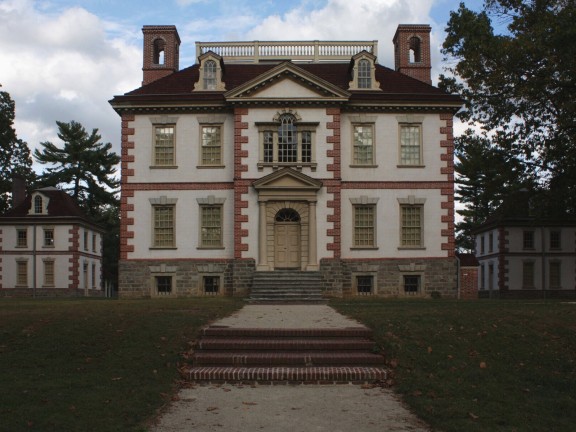Mount Pleasant

Mount Pleasant is the most ambitious of the “villas” erected on the banks of the Schuylkill by eighteenth-century Philadelphians. These houses served principally as country retreats, but some, including Mount Pleasant, were also working farms—or “plantations.”
Scottish-born privateer John Macpherson (1726–1792) and his first wife Margaret built the grand house that they called “Clunie” in 1761-1762. He had made a fortune raiding French and Spanish shipping in the Caribbean on behalf of the British during the Seven Years War, and he spent lavishly in building and furnishing his home. The architect/builder was Thomas Nevell (1721-1797), who had apprenticed with Edmund Woolley, the builder of Independence Hall. Martin Jugiez (ca. 1735-1815), a master woodcarver who had worked at Christ Church, was responsible for the elaborate interior woodwork.
The house is sited symmetrically between its two “dependencies” (the southern of which was the summer kitchen) with the fashionable a formality of an English country house in the Palladian style. The robust details—a boldly modillioned cornice and beefy brick quoining at the corners—are typical of the best mid-eighteenth-century work. Inside, Jugiez’s virtuoso woodwork is also strongly modeled, with sinuous, sometimes naturalistic features that might be called Rococo.
In the unusual plan, the stairway is shunted to a corner, which allows the central hall, where the stair would usually be located, to run all the way from front to back and afford views of the river below. Visiting Philadelphia in 1775, John Adams called Mount Pleasant the estate “the most elegant seat in Pennsylvania.”
The Macphersons farmed over 100 acres. They grew hay, fruit, and vegetables and raised livestock. A diversity of labor worked the land, including free white and Black laborers, indentured servants, and at least four enslaved Africans.
Macpherson began renting Mount Pleasant to tenants, and during the revolution he leased it to the Spanish minister, Juan de Miralles. The American major general Benedict Arnold (1741-1801) bought the estate in 1779 as a gift for his second wife Margaret “Peggy” Shippen. The Shippens were loyalists, and Peggy was a British spy who facilitated Arnold’s plan to surrender the important fort at West Point to the British without a fight. When the plan was discovered, he defected to the British, who made him a brigadier general. The Arnolds never had a chance to occupy Mount Pleasant.
The home passed through several hands until 1792, when it was purchased by General Jonathan Williams, the first superintendent of the West Point military academy. His children sold the estate to Fairmount Park, which operated it variously as a dairy farm and a beer garden until 1926, when it was restored by the Philadelphia Museum of Art.